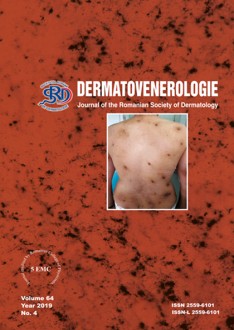Introduction: The diagnosis of erythroderma is
frequently challenging due to subtle clinical and
paraclinical signs necessary to differentiate between a
variety of underlying dermatoses, infections or systemic
diseases. The management is also difficult, with severe
systemic complications that impose an early medical
intervention.
Objective: We aimed to analyze the epidemiological,
clinical, and therapeutic profile of patients diagnosed with
erythroderma in a tertiary dermatology referral center from
Romania.
Materials and methods: We conducted a
retrospective descriptive study of patients diagnosed with
erythroderma in the Dermatology and Allergology Clinic,
„Elias” Emergency University Hospital, Bucharest,
Romania from January 2012 to August 2018. An in-depth
analysis of the clinical, paraclinical, as well as therapeutic
management was performed.
Results: The most frequent cause of erythroderma was
represented by the exacerbation of psoriasis, followed by
other chronic inflammatory dermatoses, as well as by
hypersensitivity reactions to drugs. Less frequently,
erythroderma was a paraneoplastic manifestation or a
clinical presentation of rare genetic or autoimmune
pathologies. The therapeutic management led to favorable
results, with the remission or the amelioration of the
disease. Few patients needed supportive care.
Conclusions: Although the prognosis of the majority
of patients was favorable, it is important to take into
consideration the possibility of an associated cancer
diagnosis. The dermatologist plays an essential role within
the multidisciplinary team involved in the diagnosis and
management of erythroderma.
Original articles
ERYTHRODERMA: A RETROSPECTIVE STUDY OF CASES DIAGNOSED IN A TERTIARY DERMATOLOGY REFERRAL CENTER


